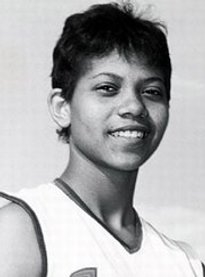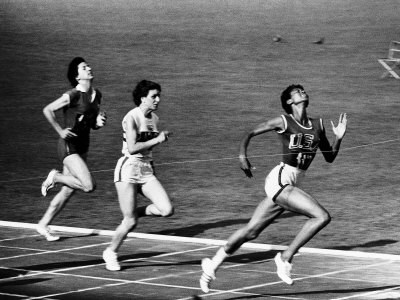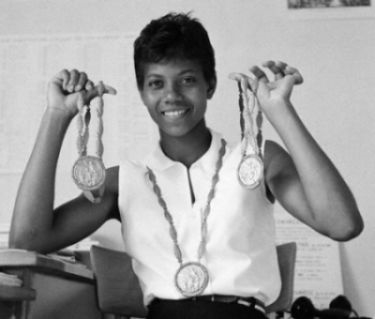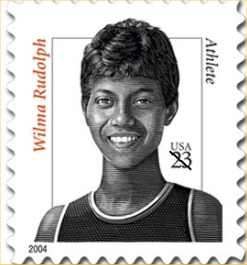 |
| Wilma Rudolph (http://www.girls-explore.com/bios/wilma-rudolph.php) |
"My doctors told me I would never walk again.
My mother told me I would. I believed my mother" (Wilma Rudolph
Quotes). Believing her mother, Wilma Rudolph arose as one of the best
runners in the world. On June 23, 1940, Wilma Glodean Rudolph became the newest
member of an already large and poor family. She was often sick as a toddler and
although she survived through polio, it rendered her left leg paralyzed. Not a
single doctor believed that she would be able to walk again. Despite all this,
Rudolph learned to walk, participated in the Olympics when she was only
sixteen, and set numerous world records. As glamorous as her life seemed, Wilma
Rudolph, an African American woman, lived during a period of segregation. But instead
of feeling hated, she continuously used the fame she received from her
miraculous victories to bring more light to the unappreciated African American
race. Other than helping African Americans, she also founded organizations and
joined many programs to aid talented young athletes who didn't have access to
professional training. Although she started out with greater struggles that the
young athletes she was helping, Wilma Rudolph's determination and perseverance
brought her to the top, along with the opportunity to become a mentor and
benefactor to young ones.
 |
| Rudolph wins the 100m dash in the 1960 Olympics.. (http://ballerssports.com/) |
Regardless of her complicated
childhood, Wilma Rudolph's firm determination to overcome illnesses,
disability, and discrimination never failed her. Wilma Rudolph lost the use of
her left leg at the age of four due to polio. She was fitted with a brace, and
doctors told her that she had to wear it from morning to night, but "When
her parents were not around, Rudolph often took off the brace and tried to walk
without a limp...the desire to walk like everyone else, became a driving force
in her life" ("Wilma Rudolph." Notable Sports Figures). Despite
being told by all the doctors that she would never be able to walk again, Wilma
Rudolph relentlessly tried to. Rudolph was not a person who gained satisfaction
from sitting in a chair while all the other kids were running around, so even
when she felt weak and fatigued, her inner strength fueled her desire to
prove the doctors wrong and walk like all the other children. The will to walk
became the engine that powered her life, and at the age of twelve, after eight
years of sitting, Wilma Rudolph was able to walk all by herself. She won her
first Olympic medal when she was sixteen, only four years after learning how to
walk. Recalling her experience of winning a bronze medal in the 1956 Olympics,
Wilma Rudolph "...told a reporter for the Chicago Tribune, "I
remember going back to my high school this particular day with the bronze
medal...They passed my bronze medal around so that everybody could touch, feel
and see what an Olympic medal is like. When I got it back, there were
handprints all over it. I took it and I started shining it up. I discovered
that bronze doesn't shine. So, I decided, I'm going to try this one more time.
I'm going to go for the gold" (Wilma Rudolph. Notable Sports
Figures). Wilma Rudolph always looked forward to the future and never regretted
her past. Even though she had already achieved a feat that others only dream
about, she did not feel content with a result that did not show her best. The
dream of earning a gold medal motivated Wilma Rudolph to continue intense
training and participate in the 1960 Olympics and earn a gold
medal. Although limited because of her race and gender, her strong will
relentlessly propelled her forward.
 |
| Wilma Rudolph and her three gold medals. (http://www.gardenofpraise.com) |
Many people are determined to
achieve a goal, but they forget that they need perseverance too. Unlike others,
Wilma Rudolph possessed both qualities. She strived to pursue her hopes,
dreams, and goals despite many hardships that were thrown her way. No one could
ever forget Wilma Rudolph in the 1960 Olympics. She gleamed as the first
American woman to earn three gold medals in track and field, but her triumphs
were not the factors that made her unforgettable. Rudolph's "...wins were
even more amazing because on the day before the 100-meter semifinal event, she
stepped in a hole and twisted her ankle. It swelled and became painful, but
Rudolph ran anyway, and won all of her events." (Wilma Rudolph.
Notable Sports Figures). Wilma Rudolph's ability to endure represented one of
her biggest strengths. Despite suffering a twisted and swollen ankle, Rudolph
still ran in her events and won them all. Not only did she prevail over
physical pain, but she also displayed to others her mental strength. Wilma
Rudolph's actions tell us that to achieve something in life, you must truly
understand your dreams to overcome all other obstacles. Rudolph never let
anything hamper her success. Even though her childhood consisted of numerous
difficulties, Rudolph became a victorious woman in both her success in running
and generosity to her community: "She was a woman and an African American
in a time when fewer opportunities existed for both groups, and she also
overcame serious childhood illness and disability to not only walk normally,
but win gold medals in national and Olympic competition" ("Wilma
Rudolph." Notable Sports Figures). In her childhood years, Rudolph had to
cope with illnesses and disability. She also lived during a time when African
Americans were considered inferior and woman had considerably lower status than
men. However, she ignored all the negative events in her life and relentlessly
worked to achieve her dreams. Wilma Rudolph surpassed all other people and eventually
arrived at the top of the status pyramid. Rudolph's perseverance not only
helped her win races, but it also aided her in society. She defeated childhood
illnesses and diseases, learned to walk, and sailed through a period of intense
prejudice.
 |
| Picture Book: Wilma Unlimited (http://www.betterworldbooks.com ) |
Although Wilma Rudolph became an
exceptional athlete, her respectable figure to young ones as a mentor and
benefactor brought her more love than other famous sport figures. Out on the track, she was an ambitious young woman,
but when she was with the younger generation she became more than just an
athlete. After Wilma Rudolph retired from her track and field
career, she began to use the attention that she had to shine attention on young
ones in need. "Since Rudolph's great joy in life came from working with young
people, in 1982 she established the Wilma Rudolph Foundation...a nonprofit
organization that trains young and disadvantaged athletes for international
competition. In 1991, Rudolph became actively involved in Walking for Wellness,
a national physical fitness program designed to get minority children walking
for health" (Markland). Wilma Rudolph used her fame as an advantage to
help these young people. With that, she formed her greatest legacy, the Wilma
Rudolph Foundation, a non-profit organization founded with one goal:
to give support to underprivileged athletes and to nurture them. It offered
free professional coaching in various sports and simultaneously assisted the
athletes with academic support. Rudolph was also enthusiastically involved in
many other programs to help disabled children, such as Walking for Wellness. She
constantly displayed her love of supporting young people. Wilma Rudolph often
gave motivational speeches to young ones, telling them to believe in themselves
and aim high. Rudolph's personal story inspired other athletes and brought her
even more opportunities to support those who suffered as she had.
"Vice President Hubert Humphrey invited her to work with him on Operation
Champion in 1967. The program was designed to take star athletes from sixteen
of the largest city ghettos in the country and give them professional
training. Rudolph became one of the track specialists" (Wilma Rudolph.
U*X*L Biographies). Rudolph did not scowl upon others because of the color of their
skin or their religion, even if they were from "sixteen of the largest
city ghettoes in the country." Instead of looking down on amateur
athletes, Rudolph was delighted to assist them in their training and guiding
them to a better future. Wilma Rudolph was always there for needy kids, for she
not only trained them in sports, but she also gave them mental support and
stability. She was a teacher, not only an athlete.
 |
| Wilma Rudolph stamp. (http://www.phillysportstc.com/wilma_rudolph.htm ()) |
Through her accomplishments and
contributions, Wilma Rudolph proved to the world that one did not need money to
succeed as long as one maintained a strong will and a strong heart. In her free
time, Rudolph often wondered what her purpose in the world was: "When I
was going through my transition of being famous, I tried to ask God why was I
here? what was my purpose? Surely, it wasn't just to win three gold medals.
There has to be more to this life than that" ("Wilma Rudolph
Quotes"). Rudolph knew winning three gold medals did not mean she had
reached the peak of her achievements, but rather that there was always a more
meaningful reward to obtain. Understanding what her real purpose was, Wilma
Rudolph became a lovable figure to many children while she fought her way
through discrimination. Rudolph's "...homecoming parade in Clarksville was
attended by over 40,000 people, and was the first racially integrated event in
the history of the town--at her insistence, since she refused to participate in
the segregated event that the white town officials originally proposed"
(Wilma Rudolph. Notable Sports Figures). While others used their
fame to attract even more attention to themselves, Rudolph used her fame to
create a better world by changing children's lives and proposing the integration
of all races. Her achievements also opened up more opportunities for future
women. Even though Rudolph had all the fame she could ever want, that was not
her main goal in life. She dedicated herself to supporting those who never
had it and to influence future generations. From a disabled child to a
brilliant athlete and respected figure in her local community and the world,
Wilma Glodean Rudolph was exactly what the French called her: "The Black
Pearl."
Markland, Mary E. "Wilma Rudolph." Great Lives
From History: African Americans (2010): 153.
Biography Reference Center. Web. 12 Dec. 2011.
"Wilma Rudolph." Notable Sports Figures. Ed. Dana R. Barnes. Detroit: Gale, 2004.Gale Biography In Context. Web. 7 Dec. 2011.
"Wilma Rudolph." U*X*L Biographies. Detroit: U*X*L, 2003. Gale Student Resources In Context. Web. 11 Dec. 2011
"Wilma Rudolph Quotes." Women's History - Comprehensive Women's History Research Guide. Web. 05 Jan. 2012. .
Page created on 1/14/2012 12:00:00 AM
Last edited 1/14/2012 12:00:00 AM
